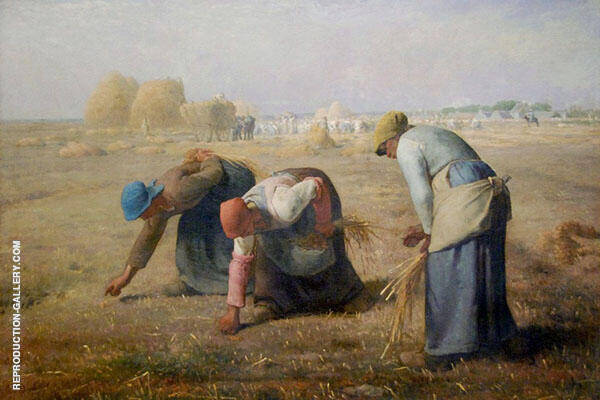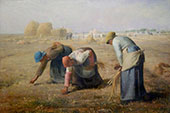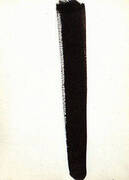The Gleaners 1857 By Jean Francois Millet
Jean Francois Millet, The Gleaners depicts three peasant women cleaning stray wheat stalks. The Gleaners 1857 is one of Millet’s most famous paintings.
Millet's oil painting sympathetically presents the plight of the French working glasses.
Gleaning is the process of collecting leftover crops from agricultural fields after gathering in the harvest. It is a process described in the Bible (for instance, in the Book of Ruth) and an activity that became a legal right of the poor in many Christian countries.
Why did Jean-Francois Millet paint The Gleaners?
Amongst Jean François Millet artwork, The Gleaners is famous for presenting the lowest ranks of society in a realistic, compassionate manner. Millet aimed to present the harsh reality of rural farming life.
Beyond the hard-working hungry women, the riches of a bountiful harvest are visible in the sunlit background.
Known as Des Glaneuses in French, the painting initially appeared at the Paris Salon of 1857. Middle and upper-class audiences treated the theme with suspicion.
Given the recent French history of violent revolution and class warfare, one critic described it as a disturbing allusion to “the scaffolds of 1793”, referring to the “Reign of Terror” organized by the French Revolutionary Tribunal.
At the time of The Gleaners debut, France had just come out of the 1848 French Revolution. Millet’s glorification of the working classes particularly affronted gallery-going audiences.
Millet's painting was criticized not only for its socialist message but also for its size. This oil painting on canvas measures over 84 by 112 centimeters, a considerable scale for art depicting “mere” labor.
During this period, paintings of this size depict religion, royalty, or mythological narratives. The three “real” women take on monumental proportions because Millet's painting represents no such themes. Indeed, one critic's complaint refers to the women’s “gigantic pretensions” and complains of their great “ugliness and grossness.”
Why are Millet's paintings important?
The Gleaners is an important oil painting in its own right. It is a shining example of French Realism and offers insights into the everyday life of the French working classes.
Another painting byJean-François Millet The Sower (painted seven years earlier), depicts a similar theme. Indeed, Millet had a deep affinity with the peasant classes. In this painting, a single peasant on a monumental scale works with dramatic dynamism.
Unlike The Gleaners, the man's labor has heroic hope and dignity. For the three women, however, there appear to be no such redeeming qualities.
These artworks particularly inspired Van Gogh and the post-impressionist movement. Van Gogh once described Millet as “the essential modern painter” who depicted the peasantry rising from the earth they tended.
Van Gogh employed a similar color palette (with a much thicker application of paint) in The Potato Eaters (1885).
How much is The Gleaners painting worth?
At the Paris Salon of 1857, Millet sold The Gleaners to a British businessman for 3,000 francs. The sale price was a thousand less than he hoped to achieve, and the artist attempted to keep the low price a secret. But, struggling for money at the time, Millet felt he had to sell the painting.
While the critical reception of Millet’s painting remained largely negative during his lifetime, it became more popular after the artist’s death in 1875. In the subsequent ten years, Jean-François Millet paintings significantly increased in value.
Ferdinand Bischoffsheim purchased Millet's oil on canvas painting and sold it for 300,000 francs in 1889 to the Champagne magnate Jeanne-Alexandrine Louise Pommery.
Pommery donated the painting to the Louvre museum in her will, gifting the artwork to the state. It now hangs in the Musée d'Orsay in Paris. The Angelus c1867 is another of Jean-Francois Millet's paintings held by the Museum.
Buy famous art reproductions by Barbizon School artists and enjoy our extensive catalog of replica paintings by Jean Francois Millet.
We offer a 100% money back guarantee or replacement service. If for any reason you are dissatisfied with your painting please contact us within 7 days of receipt, advising the reason you are unhappy and we will provide you with all the information you need for its return or replacement.
We ship free to anywhere in the world via FedEx or DHL expedited service with online tracking.
Your painting will be shipped rolled in strong plastic tubing, ready for stretching and/or framing locally. This is the conventional method of transporting hand-painted oil on canvas. Learn more about how your painting is shipped.
We are able to offer a framing service intercontinental U.S. Please contact us if you would like a quotation. Alternatively, should you prefer, we can recommend a framer in your area.
Notes About Your Painting
Please note that replica oil paintings are finished with an additional 10cm (4") of extra canvas on all sides, allowing ample surplus canvas for stretching and framing.
Cannot Find What You Are Looking For?
Reproduction Gallery Information
Customer Service
(Send Us A Message)
Tel: (503) 937 2010
Fax: (503) 937 2011








